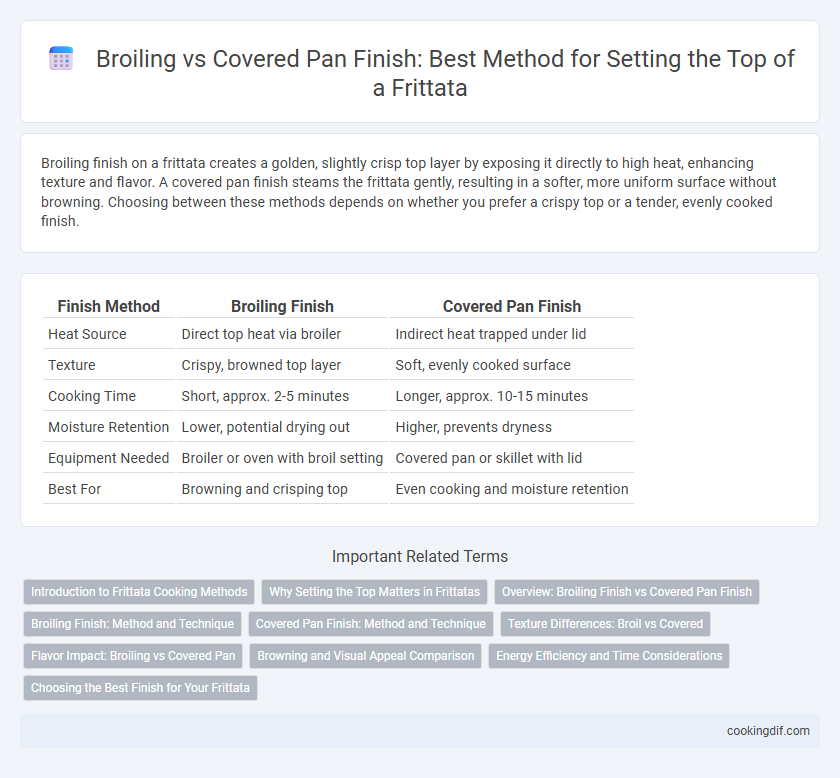Broiling finish on a frittata creates a golden, slightly crisp top layer by exposing it directly to high heat, enhancing texture and flavor. A covered pan finish steams the frittata gently, resulting in a softer, more uniform surface without browning. Choosing between these methods depends on whether you prefer a crispy top or a tender, evenly cooked finish.
Table of Comparison
| Finish Method | Broiling Finish | Covered Pan Finish |
|---|---|---|
| Heat Source | Direct top heat via broiler | Indirect heat trapped under lid |
| Texture | Crispy, browned top layer | Soft, evenly cooked surface |
| Cooking Time | Short, approx. 2-5 minutes | Longer, approx. 10-15 minutes |
| Moisture Retention | Lower, potential drying out | Higher, prevents dryness |
| Equipment Needed | Broiler or oven with broil setting | Covered pan or skillet with lid |
| Best For | Browning and crisping top | Even cooking and moisture retention |
Introduction to Frittata Cooking Methods
Broiling finish exposes the frittata's top to direct radiant heat, creating a golden, slightly crispy crust that enhances texture and flavor. Covered pan finish relies on steam trapped under a lid, gently cooking the top to a soft, custard-like consistency without browning. Selecting between broiling and covered pan finishes influences the frittata's appearance and mouthfeel, catering to different culinary preferences.
Why Setting the Top Matters in Frittatas
Setting the top of a frittata ensures even cooking and prevents runny eggs, which is essential for achieving the perfect texture and a visually appealing presentation. A broiling finish quickly firms the top with a slightly browned, crisp surface, ideal for those who prefer a golden crust, while a covered pan finish gently steams the top, resulting in a softer, more uniform set. The method chosen impacts moisture retention and doneness, making top setting a crucial step in mastering frittata consistency and flavor.
Overview: Broiling Finish vs Covered Pan Finish
Broiling finish for frittatas provides a quick, high-heat method that creates a golden, slightly crisp top layer, enhancing texture and flavor through caramelization. Covered pan finish relies on residual steam and gentle heat to set the top evenly, resulting in a softer, custard-like consistency without browning. Choice between techniques depends on desired texture: broiling for a crisp finish or covered pan for a moist, tender outcome.
Broiling Finish: Method and Technique
Broiling finish involves placing the frittata under high heat in the oven's broiler to quickly set and brown the top, creating a golden, slightly crisp surface. This technique requires careful monitoring to prevent burning while achieving an even, bubbly texture. Using a broiler-safe pan or transferring the frittata to a broiler-proof dish ensures optimal heat exposure for a perfectly finished top.
Covered Pan Finish: Method and Technique
The covered pan finish method for setting the frittata's top involves placing a lid or a tight-fitting cover on the pan during the final cooking stage to trap steam and evenly cook the surface without direct heat. This technique prevents the top from drying out and results in a moist, tender texture by gently steaming the eggs. Using a covered pan finish requires maintaining moderate heat and checking periodically to avoid overcooking or trapping excessive moisture.
Texture Differences: Broil vs Covered
Broiling a frittata creates a golden, slightly crisp top that adds a pleasing contrast to the creamy interior, enhancing textural complexity. A covered pan finish, however, steams the top, resulting in a uniformly soft and tender surface without any browning. Choosing broiling produces a firmer crust and intensified flavor, while covering preserves moisture and promotes a delicate, custard-like texture.
Flavor Impact: Broiling vs Covered Pan
Broiling a frittata develops a caramelized, slightly charred crust that intensifies flavor through Maillard reaction, adding a smoky depth and appealing texture contrast. A covered pan finish steams the top gently, preserving moisture and delivering a tender, uniform set with subtle, delicate flavors. Choosing broiling elevates taste complexity and visual appeal, while covered cooking emphasizes creaminess and softness in the frittata's flavor profile.
Browning and Visual Appeal Comparison
Broiling finish on a frittata enhances browning by directly exposing the top to high, intense heat, producing a crispy, golden crust with appealing caramelization and visual contrast. In contrast, a covered pan finish traps steam, resulting in a softer, less browned surface with minimal visual texture but a moist consistency. Choosing broiling yields a more pronounced, appetizing browned appearance, while covered pan finishing favors a tender, uniformly cooked top with subtle coloration.
Energy Efficiency and Time Considerations
Broiling finish for frittatas uses intense direct heat, which sets the top quickly and reduces overall cooking time, making it energy-efficient for busy kitchens. Covered pan finishes rely on steam to cook the top evenly but require longer cooking times and continuous heat, increasing energy consumption. Choosing broiling ensures faster service and lower energy use, while covered pan methods offer gentler heat at the cost of time and efficiency.
Choosing the Best Finish for Your Frittata
Broiling finish achieves a golden, slightly crisp top by exposing the frittata directly to high heat, ideal for recipes needing a dramatic, caramelized surface. Covered pan finish traps steam, creating a moist and tender top with even cooking, suitable for delicate frittatas with softer textures. Selecting the best finish depends on desired texture--broiling for a crispy edge or covered pan for a uniform, soft set.
Broiling Finish vs Covered Pan Finish for setting top Infographic

 cookingdif.com
cookingdif.com